Small overlap front: driver-side
Rating applies to 2015-19 models
Tested vehicle: 2015 Kia Soul wagon
The Kia Soul was redesigned for the 2014 model year. Beginning with 2015 models, the front-end and occupant compartment structure was strengthened to improve occupant protection in small overlap frontal crashes.
| Evaluation criteria | Rating |
|---|---|
| Structure and safety cage | |
| Driver injury measures | |
| Head/neck | |
| Chest | |
| Hip/thigh | |
| Lower leg/foot | |
| Driver restraints and dummy kinematics | |

Action shot taken during the driver-side small overlap frontal crash test.

The dummy's position in relation to the door frame, steering wheel, and instrument panel after the crash test indicates that the driver's survival space was maintained reasonably well.
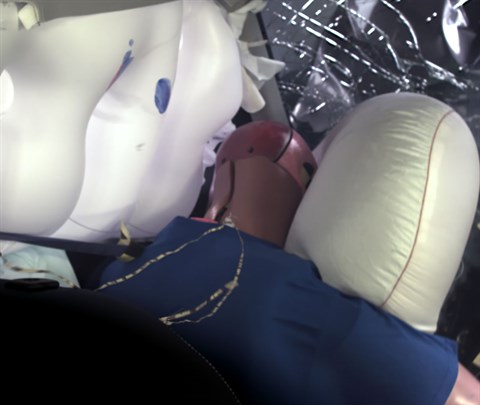
The frontal and side curtain airbags worked well together to keep the head from coming close to any stiff structure or outside objects that could cause injury.
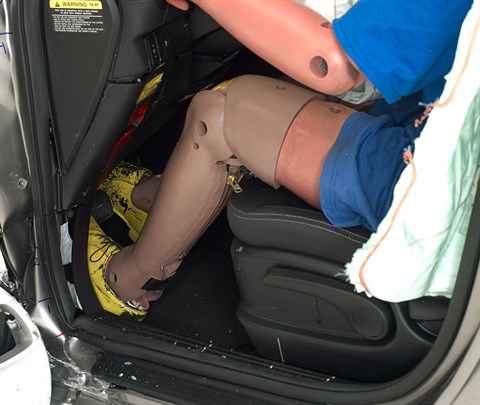
The driver's space was maintained reasonably well, and risk of injuries to the dummy's legs and feet was low.
Small overlap front: passenger-side
Rating applies to 2015-19 models
Tested vehicle: 2018 Kia Soul wagon
The Kia Soul was redesigned for the 2014 model year. Beginning with 2015 models, the front-end and occupant compartment structure was strengthened to improve occupant protection in small overlap frontal crashes.
Two passenger-side small overlap frontal tests of the Soul were conducted, one by the Institute of a 2018 model and the other by Hyundai/Kia of a 2017 model. Ratings are based on both tests.
| Evaluation criteria | Rating |
|---|---|
| Overall evaluation | |
| Structure and safety cage | |
| Passenger injury measures | |
| Head/neck | |
| Chest | |
| Hip/thigh | |
| Lower leg/foot | |
|
Passenger restraints and dummy kinematics
In both tests, the dummy’s head contacted the frontal airbag but then moved off toward the right side. In the Institute's test, the head moved so far forward and to the right that it hit the dashboard. The side curtain airbag deployed and has sufficient forward coverage in both tests to protect the head from contact with side structure and outside objects. The side torso airbag also deployed. | |
| Driver injury measures | |
| Head/neck | |
| Chest | |
| Hip/thigh | |
| Lower leg/foot | |
| Driver restraints and dummy kinematics | |
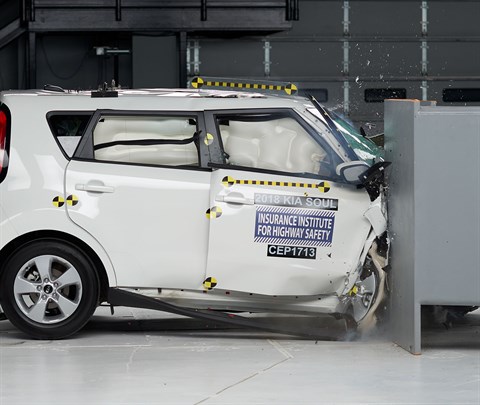
Action shot taken during the Institute's passenger-side small overlap frontal crash test.
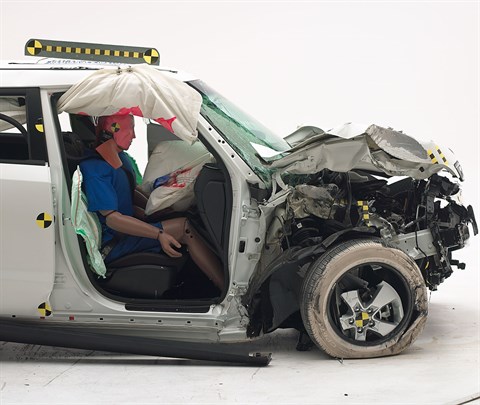
The dummy's position in relation to the door frame and dashboard after the crash test indicates that the passenger's survival space was maintained well (Institute test car shown).
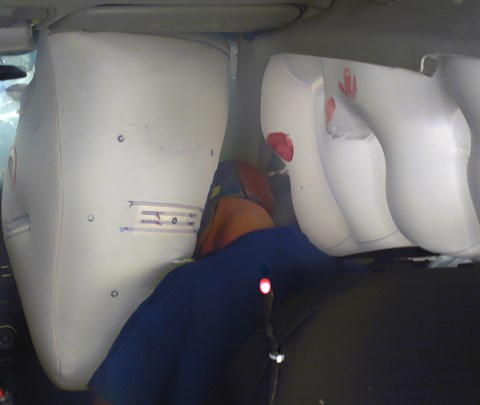
The dummy’s head slid off the right side of the frontal airbag and moved far enough forward to hit the dashboard hard (Institute test shown).

The passenger's space was maintained well in both tests, but forces on the right lower leg were just high enough to indicate the possibility of injuries in the test conducted by Hyundai/Kia. In the test conducted by the Institute (pictured), injury risk to both legs and feet was low.
Moderate overlap front: original test
Rating applies to 2014-19 models
Tested vehicle: 2014 Kia Soul Plus wagon
The Kia Soul was redesigned for the 2014 model year. Moderate overlap frontal ratings are assigned by the Institute based on a test conducted by Hyundai/Kia.
| Evaluation criteria | Rating |
|---|---|
| Overall evaluation | |
| Structure and safety cage | |
| Driver injury measures | |
| Head/neck | |
| Chest | |
| Leg/foot, left | |
| Leg/foot, right | |
| Driver restraints and dummy kinematics | |
Side: original test
Rating applies to 2014-19 models
Tested vehicle: 2014 Kia Soul wagon with standard front and rear head curtain airbags and standard front seat-mounted torso airbags
The Kia Soul was redesigned for the 2014 model year. Side ratings are assigned by the Institute based on a test conducted by Hyundai/Kia. (The car tested was designated as a 2012 model but included all of the design changes of the 2014 models.)
| Evaluation criteria | Rating |
|---|---|
| Overall evaluation | |
| Structure and safety cage | |
| Driver injury measures | |
| Head/neck | |
| Torso | |
| Pelvis/leg | |
| Driver head protection | |
| Rear passenger injury measures | |
| Head/neck | |
| Torso | |
| Pelvis/leg | |
| Rear passenger head protection | |
Roof strength
Rating applies to 2014-19 models
Tested vehicle: 2014 Kia Soul Plus wagon
| Overall evaluation | |
|---|---|
| Curb weight | 2,905 lbs |
| Peak force | 15,304 lbs |
| Strength-to-weight ratio | 5.27 |
Head restraints & seats
Seat type: Cloth, manual seat
| Overall evaluation | |
|---|---|
| Dynamic rating | |
| Seat/head restraint geometry |
About the head restraint & seat test
Currently, IIHS tests apply only to front seats.
Headlights
Ratings are given for 2 different headlight variations available on this vehicle.
Trim level(s)
- + trim equipped with Primo Lit package
- ! trim equipped with Technology package
| Evaluation criteria | Rating |
|---|---|
| Low-beam headlight type | HID projector |
| High-beam headlight type | HID projector |
| Curve-adaptive? | No |
| High-beam assist? | No |
|
Overall rating | |
| Distance at which headlights provide at least 5 lux illumination: | |
Low beams
On the straightaway, visibility was good on both sides of the road. On curves, visibility was good in all 4 tests.
The low beams never exceeded glare limits.
High beams
On the straightaway, visibility was good on the right side of the road and fair on the left side. On curves, visibility was good on the gradual left and gradual right curves and fair on the sharp right and sharp left curves.
Trim level(s)
- Base trim
- + trim
- ! trim
| Evaluation criteria | Rating |
|---|---|
| Low-beam headlight type | Halogen reflector |
| High-beam headlight type | Halogen reflector |
| Curve-adaptive? | No |
| High-beam assist? | No |
|
Overall rating | |
| Distance at which headlights provide at least 5 lux illumination: | |
Low beams
On the straightaway, visibility was fair on both sides of the road. On curves, visibility was inadequate in all 4 tests.
The low beams never exceeded glare limits.
High beams
On the straightaway, visibility was fair on the right side of the road and inadequate on the left side. On curves, visibility was inadequate in all 4 tests.
Front crash prevention: vehicle-to-vehicle
Child seat anchors
Rating applies to 2015-19 models
| Evaluation criteria | Rating |
|---|---|
| Overall evaluation | |
| Vehicle trim | + |
| Seat type | cloth |
This vehicle has 2 rear seating positions with complete child seat attachment (LATCH) hardware.
It has 1 additional seating position with a tether anchor only.
| Evaluation criteria | Rating |
|---|---|
| Overall evaluation | |
| Vehicle trim | + |
| Seat type | cloth |
| Rating icon | Rating |
|---|---|
| G | Good |
| A | Acceptable |
| M | Marginal |
| P | Poor |
| Seating positions that rely on borrowed lower anchors or have only a tether anchor available are not rated. | |
thether anchor symbol | Tether anchor |
lower anchor symbol | Lower anchors |
| Lower anchor(s) can be borrowed from adjacent positions(s) | |
| No hardware available |
Details by seating position
| Position | Rating |
|---|---|
| 1 | |
| Tether anchor | |
| easy-to-find location | |
| no other hardware could be confused for anchor | |
| Lower anchors | |
| too deep in seat | |
| not too much force needed to attach | |
| easy to maneuver around anchors | |
| 2 | |
| Tether anchor | |
| easy-to-find location | |
| no other hardware could be confused for anchor | |
| Lower anchors | |
| none available | |
| 3 | |
| Tether anchor | |
| easy-to-find location | |
| no other hardware could be confused for anchor | |
| Lower anchors | |
| too deep in seat | |
| not too much force needed to attach | |
| easy to maneuver around anchors |
